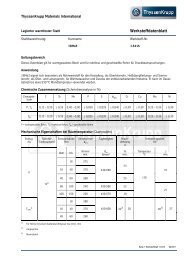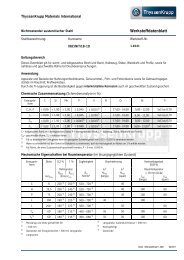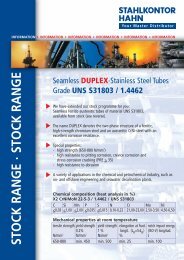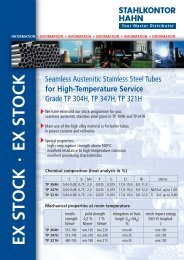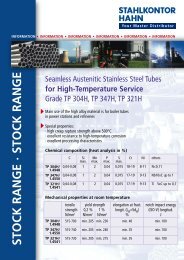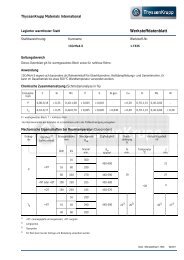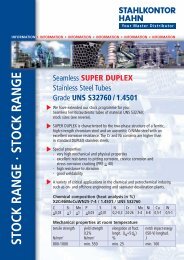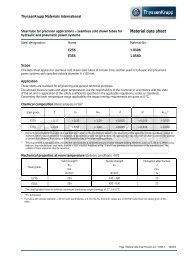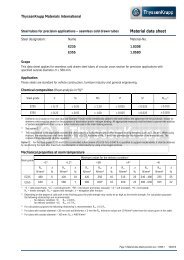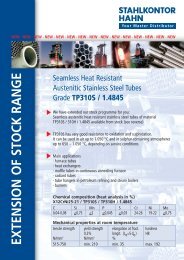You also want an ePaper? Increase the reach of your titles
YUMPU automatically turns print PDFs into web optimized ePapers that Google loves.
ThyssenKrupp Materials International<br />
Austenitic Corrosion Resistant Steel Material Data Sheet<br />
Steel Designation: Name Material No.<br />
Scope<br />
X2CrNiMo17-12-2 <strong>1.4404</strong><br />
This data sheet applies to hot and cold rolled sheet and strip, semi-finished products, rods, rolled wire and profiles as<br />
well as seamless and welded tubes for pressure purposes.<br />
Application<br />
Construction encasement, doors, windows and armatures; offshore modules; cisterns and pipes for chemical tanker;<br />
production, warehousing and overland transportation of chemicals, food and beverages; pharmacy, synthetic fiber,<br />
paper and textile plants; pressure vessels.<br />
Due to the low C-content, the resistance to intergranular corrosion is also guaranteed in the welded condition.<br />
Chemical <strong>com</strong>position (heat analysis in %)<br />
Product form C Si Mn P S N Cr Mo Ni<br />
C, H, P ≤ 0.030 ≤ 1.00 ≤ 2.00 ≤ 0.045 ≤ 0.015 1) ≤ 0.11 16.50 - 18.50 2.00 - 2.50 10.00 - 13.00<br />
L ≤ 0.030 ≤ 1.00 ≤ 2.00 ≤ 0.045 ≤ 0.030 1) ≤ 0.11 16.50 - 18.50 2.00 - 2.50 10.00 - 13.00 2)<br />
T W ≤ 0.030 ≤ 1.00 ≤ 2.00 ≤ 0.045 3) ≤ 0.015 3) ≤ 0.11 16.50 - 18.50 2.00 - 2.50 10.00 - 13.00<br />
T S ≤ 0.030 ≤ 1.00 ≤ 2.00 ≤ 0.040 ≤ 0.015 1) ≤ 0.11 16.50 - 18.50 2.00 - 2.50 10.00 - 13.00 2)<br />
C = cold rolled strip; H = hot rolled strip; P = hot rolled sheet; L = semi-finished products, rods, rolled wire and profiles<br />
T W = welded tubes; TS = seamless tubes<br />
1) For machinability a controlled sulphur content of 0.015-0.030 % are re<strong>com</strong>mended and permitted.<br />
2) If it is necessary to minimize the content of delta ferrite, it is allowed to increase the maximum content of nickel by 1.5 %.<br />
3) For tubes, which are welded without filler metal, P + S max. 0.040 %.<br />
Mechanical properties at room temperature in solution annealed condition<br />
Product Tick- 0,2 % 1 % Tensile<br />
Elongation Impact energy<br />
form ness<br />
strength<br />
(ISO-V)<br />
Yield strength A1) A1) Room temperature<br />
mmmax Rp0,2 Rp1,0 N/mm² min<br />
Rm N/mm²<br />
% min<br />
(longitudinal)<br />
% min<br />
(transvers)<br />
≥ 10 mm thick<br />
Jmin Jmin (longitudinal) (transverse)<br />
C 8 2403) 2703) 530 - 6803) - 40 - -<br />
H 13,5 220 3) 260 3) 530 - 680 3) - 40 100 60<br />
P 75 220 3) 260 3) 520 - 670 3) - 45 100 60<br />
L 160 200 4) 235 4) 500 - 700 4) 40 - 100 -<br />
L 250 2) 200 5) 235 5) 500 - 700 3) - 30 - 60<br />
T W/S 60 190 6) 225 6) 490 - 690 4) 40 30 100 60 7)<br />
1) Gauge length and thickness according to DIN EN<br />
2) > 160 mm<br />
4) Longitudinal test piece<br />
5) Transverse test piece<br />
3) Transverse test piece, with product widths < 300 mm longitudinal test piece 6) Longitudinal test piece, external diameter > 508 mm transverse test piece<br />
7) min. 60 J at -196 °C<br />
Page 1 Material Data Sheet <strong>1.4404</strong> 11/2011
ThyssenKrupp Materials International<br />
Reference data on some physical properties<br />
Density at 20 °C Modulus of elasticity Thermal conductiv- Specific thermal Specific electrical resistivity<br />
kN/mm² at<br />
ity at 20 °C capacity at 20 °C<br />
at 20 °C<br />
kg/dm³ 20 °C 200 °C 400 °C 500 °C W/m K J/kg K Ω mm²/m<br />
8,0 200 186 172 165 15 500 0,75<br />
Mean coefficient of thermal expansion 10 -6 K -1 between 20 °C and<br />
100 °C 200 °C 300 °C 400 °C 500 °C<br />
16,0 16,5 17,0 17,5 18,0<br />
Guidelines on the temperatures for hot forming and heat treatment 1)<br />
Hot forming Heat treatment AT (solution annealed), Microstructure<br />
Temperature °C Type of cooling Temperature °C 2) 3) 4) Type of cooling Microstructure<br />
1150 to 850 Air 1030 to 1110 Water, air Austenite with a low<br />
content of ferrite<br />
1) For simulative heat treated test pieces the temperatures for solution annealing have to be agreed.<br />
2) Solution annealing is in applicable, if the conditions for the hot forming and the concluding cooling are in such a way that the<br />
requirements for the mechanical properties of the product can be maintained.<br />
3) If heat treatment is carried out in a continuous annealing furnace, usually the upper area of the mentioned temperature range is<br />
preferred or even exceeded.<br />
4) For heat treatment within subsequent processing, the lower area of the stated temperature range for solution annealing has to be<br />
aspired, as otherwise the mechanical properties could be affected. If the lower limit for the solution annealing temperature was<br />
not undercut during hot forming, while repeating annealing a temperature of 1000 °C as the lower limit is sufficient.<br />
Processing / Welding<br />
Standard welding processes for these steel grades are:<br />
TIG<br />
MAG solid wire<br />
Arc welding (E)<br />
TIG–welding Arc welding (E)<br />
MAG–welding solid wire Submerged arc welding (SAW)<br />
Laser beam welding<br />
Process Filler metal<br />
similar higher alloyed<br />
Thermanit GE-316 L 1.4430 Thermanit A 1.4576<br />
Thermanit 18/17 E 1.4440<br />
Thermanit GE-316 L Si 1.4430 Thermanit A Si 1.4576<br />
Thermanit 18/17 E 1.4440<br />
Thermanit GE Spezial 1.4430<br />
Thermanit GEW 316 L-17 1.4430<br />
SAW<br />
Thermanit GE-316L Marathon 431<br />
Marathon 213<br />
Laser beam welding See page 3<br />
Thermanit A Spezial 1.4576<br />
Thermanit AW 1.4576<br />
Thermanit 18/17 E 1.4440<br />
Thermanit 18/17 EW 1.4440<br />
Wire Powder Wire Powder<br />
Thermanit A<br />
Thermanit 18/17 E<br />
Marathon 431+213<br />
Marathon 104<br />
When choosing the filler metal, the corrosion stress has to be regarded, as well. The use of a higher alloyed filler metal<br />
can be necessary due to the cast structure of the weld metal.<br />
A preheating is not necessary for this steel. A heat treatment after welding is normally not usual.<br />
Austenitic steels only have 30 % of the thermal conductivity of non-alloyed steels. Their fusion point is lower than that of<br />
non-alloyed steel therefore austenitic steels have to be welded with lower heat input than non-alloyed steels. To avoid<br />
Page 2 Material Data Sheet <strong>1.4404</strong> 11/2011
ThyssenKrupp Materials International<br />
overheating or burn-thru of thinner sheets, higher welding speed has to be applied. Copper back-up plates for faster heat<br />
rejection are functional, whereas, to avoid cracks in the solder metal, it is not allowed to surface-fuse the copper back-up<br />
plate.<br />
This steel has an extensively higher coefficient of thermal expansion as non-alloyed steel. In connection with a worse<br />
thermal conductivity a greater distortion has to be expected.<br />
When welding <strong>1.4404</strong> all procedures, which work against this distortion (e. g. back-step sequence welding, welding alternately<br />
on opposite sides with double-V butt weld, assignment of two welders when the <strong>com</strong>ponents are accordingly large)<br />
have to be respected notably. For product thicknesses over 12 mm the double-V butt weld has to be preferred instead of a<br />
single-V butt weld. The included angle should be 60° - 70°, when using MIG-welding about 50° are enough. An accumulation<br />
of weld seams should be avoided. Tack welds have to be affixed with relatively shorter distances from each other<br />
(significantly shorter than these of non-alloyed steels), in order to prevent strong deformation, shrinking or flaking tack<br />
welds. The tacks should be subsequently grinded or at least be free from crater cracks.<br />
<strong>1.4404</strong> in connection with austenitic weld metal and too high heat input the addiction to form heat cracks exists. The addiction<br />
to heat cracks can be confined, if the weld metal features a lower content of ferrite (delta ferrite). Contents of ferrite<br />
up to 10 % have a favorable effect and do not affect the corrosion resistance generally. The thinnest layer as possible<br />
have to be welded (stringer bead technique) because a higher cooling speed decreases the addiction to hot cracks.<br />
A preferably fast cooling has to be aspired while welding as well, to avoid the vulnerability to intergranular corrosion and<br />
embrittlement.<br />
<strong>1.4404</strong> is very suitable for laser beam welding (weldability A in accordance with DVS bulletin 3203, part 3). With a welding<br />
groove width smaller 0,3 mm respectively 0,1 mm product thickness the use of filler metals is not necessary. With<br />
larger welding grooves a similar filler metal can be used. With avoiding oxidation within the seam surface during laser<br />
beam welding by applicable backhand welding, e. g. helium as inert gas, the welding seam is as corrosion resistant as the<br />
base metal. A hot crack hazard for the welding seam does not exist, when choosing an applicable process.<br />
<strong>1.4404</strong> is also suitable for laser beam fusion cutting with nitrogen or flame cutting with oxygen. The cut edges only have<br />
small heat affected zones and are generally free of micro cracks and thus are well formable. While choosing an applicable<br />
process the fusion cut edges can be converted directly. Especially, they can be welded without any further preparation.<br />
While processing only stainless tools like steel brushes, pneumatic picks and so on are allowed, in order to not endanger<br />
the passivation.<br />
It should be neglected to mark within the welding seam zone with oleigerous bolts or temperature indicating crayons.<br />
The high corrosions resistance of this stainless steel is based on the formation of a homogeneous, <strong>com</strong>pact passive layer<br />
on the surface. Annealing colors, scales, slag residues, tramp iron, spatters and such like have to be removed, in order to<br />
not destroy the passive layer.<br />
For cleaning the surface the processes brushing, grinding, pickling or blasting (iron-free silica sand or glass spheres) can<br />
be applied. For brushing only stainless steel brushes can be used. Pickling of the previously brushed seam area is carried<br />
out by dipping and spraying, however, often pickling pastes or solutions are used. After pickling a carefully flushing with<br />
water has to be done.<br />
Remark<br />
In quenched condition the material can be slightly magnetizable. With increasing cold forming the magnetizability increases.<br />
Page 3 Material Data Sheet <strong>1.4404</strong> 11/2011
ThyssenKrupp Materials International<br />
Editor<br />
THYSSENKRUPP MATERIALS INTERNATIONAL GMBH<br />
Technical Sales / Quality Management<br />
Am Thyssenhaus 1<br />
45128 Essen<br />
References<br />
DIN EN 10088-2:2005-09 Beuth Verlag GmbH, Postfach, D10772 Berlin<br />
DIN EN 10088-3:2005-09<br />
DIN EN 10216-5:2004-11<br />
DIN EN 10217-7:2005-05<br />
MB 821 "Properties" Informationsstelle Edelstahl Rostfrei, Postfach 10 22 05,<br />
MB 822 "The converting of stainless steel" D-4013 Düsseldorf<br />
DVS bulletin 3203, part 3 Verlag für Schweißen und Verwandte Verfahren DVS Verlag GmbH,<br />
Postfach 10 19 65, D-4010 Düsseldorf<br />
Laser beam electric arc cutting of stainless steels Thyssen Lasertechnik GmbH, Aachen<br />
Laser beam – longitudinal welding of profiles of stainless steel<br />
Böhler Schweisstechnik Deutschland GmbH, Hamm<br />
Important note<br />
Information given in this data sheet about the condition or usability of materials respectively products are no warranty for<br />
their properties, but act as a description.<br />
The information, we give on for advice, <strong>com</strong>ply for the experiences of the manufacturer as well as our own. We cannot give<br />
warranty for the results of processing and application of the products.<br />
Page 4 Material Data Sheet <strong>1.4404</strong> 11/2011



